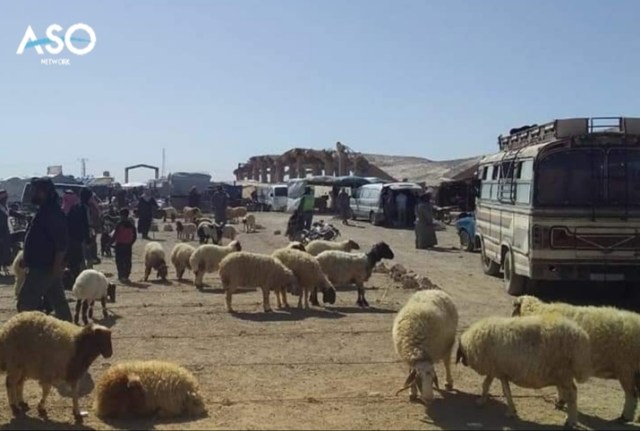News
Livestock…the challenges of lack of support in North-East Syria

Avin Alo
During the years 2021 and 2022, the regions of NE Syria witnessed a retention of rainfall, which led to the region being exposed to drought, and a decline in the production of agricultural crops and livestock, thus causing negative repercussions on food security in the region, while agriculture and livestock breeding recovered during the current year as a result. Abundant rainfall and availability of pastures.
The regions of North-East Syria are among the Syrian regions where livestock are most abundant, due to their vast area and abundance of water, especially al-Jazira region, as the people of al-Jazira mainly depend on agriculture and livestock raising.
Lack of support is one of the most prominent challenges of livestock raising
In the hope of increasing support in securing industrial fodder, livestock breeder Abd al-Nasser Hassan, 41 years old, in the village of Al-Ghanamiya in the countryside of the city of Al-Hasakah, cares for his sheep, which number more than 300 sheep.
He is forced to buy artificial fodder from the markets, despite its high price, because he does not own agricultural land and does not have pastures, unlike livestock breeders who own agricultural lands, keep quantities of barley, and use the remains of the harvest to graze livestock.
The bran material is delivered only through feed centers distributed in the region to breeders whose names are included in the 2021 census tables, and according to the ID card of the person concerned, so “Abd al-Nasser Hassan” is forced to buy barley from the markets at an amount of 450 liras per kilo, which increases the burdens of livestock breeders those whose names are not included in the census.
Livestock numbers and livestock protection measures
In order to maintain the livestock population, and because female livestock are the main source of livestock and increase their numbers through births, the Autonomous Administration does not allow the export of female livestock at all.
The statistics of livestock numbers for the year 2021 are being approved for the distribution of subsidized fodder in North-East Syria(NES), where the number of livestock is approximately 11 million heads, according to a member of the Livestock Department in NE Syria, Dr. Ahmed Eid al-Mohammad.
“Al-Mohammad” told Aso News Network that the number of livestock increases in some cities due to the presence of pastures, especially the towns of Al-Shaddadi and Markada, south of the city of Al-Hasakah. The number of livestock in the two towns reached about 4,429,000 heads of sheep, 37 thousand cows, 6 thousand camels, and 4 thousand horses. And 3,700 buffalo.
According to this census, it was decided to distribute fodder once every two months when it is available, and in the event of a shortage of fodder, the distribution is only two or three times during a year. Due to the lack of distribution centers, the administration was unable to reach all cities and rural areas. However, since the census was conducted, no distribution of fodder has been made only twice in al-Jazira.
The fodder centers are distributed in Qamishlo/Al-Qamishli, Derik/Al-Malikiyah, Tirbesipiye/Al-Qahtaniyah, Al-Hasakah, Tal Kochar, and Al-Darbasiyah.
Despite the procedures followed in distributing fodder, breeders who have increased the number of heads of their sheep complain that their numbers are not updated in census records, and the lack of the amount of fodder received, which amounts to only ten kilograms per head, in addition to the infrequent distribution times.
While the Department of Livestock in North-East Syria is preparing a new livestock census before the end of this year.
Measures must be taken to protect livestock
According to economic expert Hussein Aliwi Al-Ali, the Autonomous Administration must take more measures to preserve livestock in the region, the most important of which is preventing the export of all types of livestock, not just females, and tightening borders to prevent livestock smuggling.
Al-Ali added: “Feed materials, the most important of which is barley, must be distributed at a subsidized price, since barley, yellow corn, and bran are available and we do not need to import them from outside the country, and barley must be included among the feed materials, and the price of a kilo of feed must not exceed 1,000 Syrian pounds, and compound feeds must not exceed 1,500 Syrian pounds” “.
Water resources must also be provided to water sheep in various regions, and farmers must be supported to grow barley with seeds and diesel.
The price of sheep in Al-Jazeera markets ranges between one million and 500 thousand and 3 million Syrian pounds, and the price of goats ranges between one million and 500 thousand and two million and 500 thousand, while the price of one cow ranges between 15 million and 25 million Syrian pounds.
This year has witnessed an unprecedented rise in the prices of red meat in the cities of al-Jazira. One kilogram of meat was sold at a price of 60,000 Syrian pounds at the beginning of the year, so the Autonomous Administration issued a circular setting the price of a kilo of meat at 50,000 Syrian pounds.
The sellers did not adhere to the price specified in the circular, and as the exchange rate of the US dollar continued to rise, meat prices rose significantly and the price of a kilo of meat exceeded 100 thousand liras, or approximately 10 US dollars.
